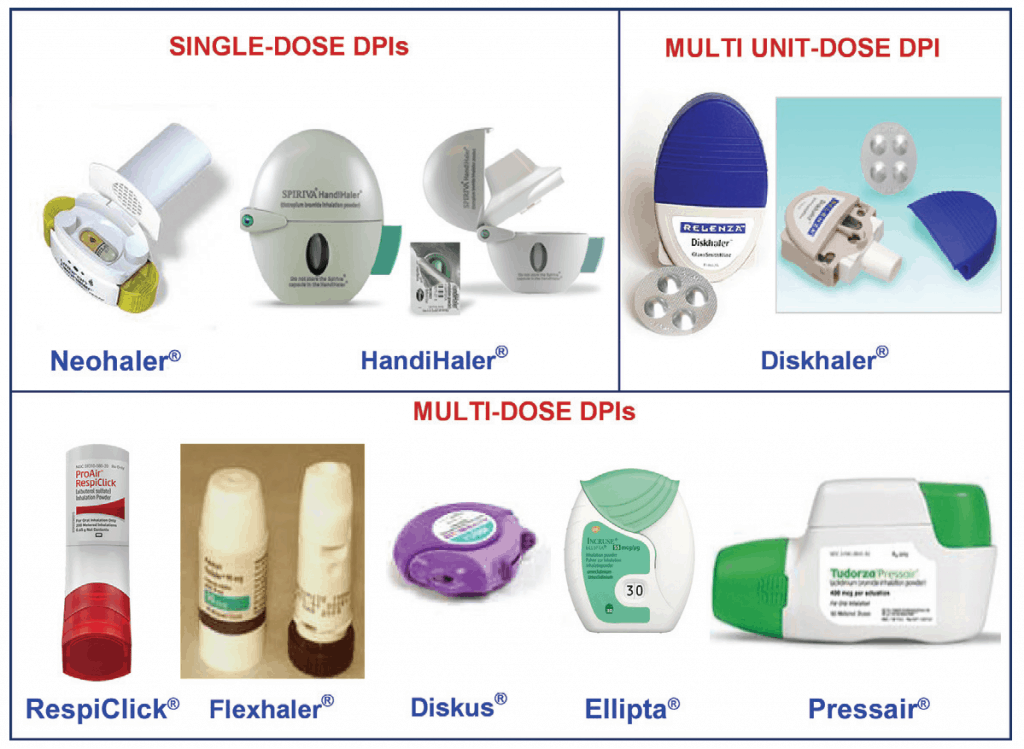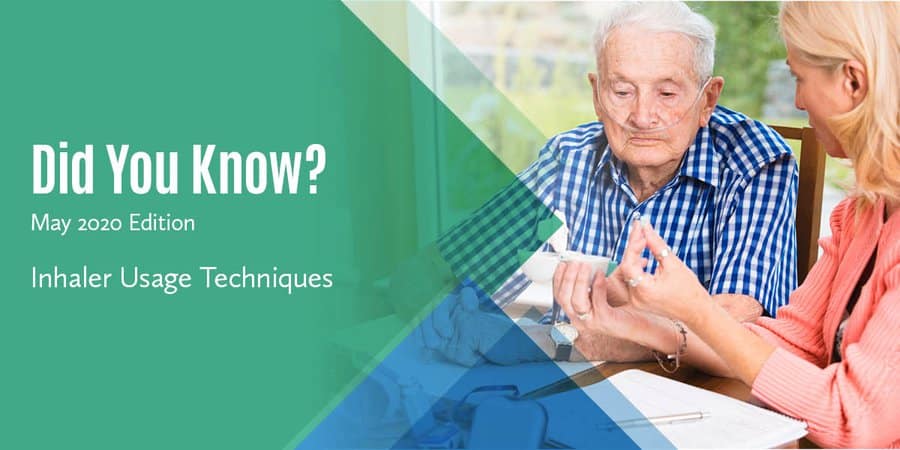Proper Use of Inhalers
Delivery of drugs via inhalation is an integral component in the treatment and management of patients with COPD and Asthma. As few as one-half to one-third of patients who are prescribed inhalers are using them correctly. Improper use of inhalers can result in little or no medication getting to the lungs to help treat the disease, which can result in increased symptoms, exacerbations, and hospital admissions.
Adequate training and practice are necessary to ensure patients are receiving optimal medication delivery. If a patient cannot use the inhaler correctly, it may be time to reevaluate the type of delivery device or change to a nebulizer.
Below you can review the proper inhaler techniques for the most commonly used inhalers.
MDI’s (Metered-dose inhalers)
MDI’s are now made with an HFA propellent. Manufacturers recommend a closed-mouth technique for inhalers made with this type of propellent. Examples of MDI’s: Advair HFA, Atrovent HFA, Bevespi, Dulera, Flovent HFA, ProAir HFA, Proventil HFA, Symbicort, Ventolin HFA, Xopenex HFA. Each manufacturer has specific instructions for how to use and the proper way to prime their inhaler.
General steps for use:
- Shake the inhaler well.
- Breathe out fully through the mouth, away from the inhaler.
- Put the mouthpiece in the mouth and tighten the lips around it.
- Press the canister down while inhaling DEEPLY AND SLOWLY through the mouth.
- Remove inhaler from the mouth and hold breath for as long as comfortably possible, generally up to ten seconds and then breathe out. Wait a minute in between each puff.
Spacers can be used with MDI’s to help those that may have difficulty timing the spray with inhalation. They can also help reduce deposition of medication in the mouth/throat and decrease the amount of swallowed medication that is absorbed through the stomach.
General steps for use with a spacer:
- Shake inhaler well.
- Attach the spacer to the inhaler with the inhaler’s canister in a vertical position.
- Breathe out fully through the mouth, away from the inhaler.
- Put the mouthpiece of the spacer between the teeth and tighten the lips around it.
- Press the canister down while inhaling DEEPLY AND SLOWLY though the mouth.
- Move the mouthpiece away from the mouth and hold breath for as long as comfortably possible, generally up to ten seconds and then breathe out. Wait a minute in between each puff. Only use one spray in the spacer at a time.
Soft-Mist Inhalers (Respimat inhalers):
Soft mist inhalers (SMIs) release medication in a fine mist that comes out more slowly and lasts longer in the air than the aerosol produced by MDIs. Refer to package insert of each device for priming instructions.
General steps for use:
- Hold the inhaler upright and turn the base in the direction of the arrows until it clicks.
- Flip the cap until it snaps open.
- Breathe out fully through the mouth, away from the inhaler.
- Put the mouthpiece in the mouth and tighten the lips around the end without covering the air vents.
- Press the dose release button and inhaler DEEPLY AND SLOWLY through the mouth.
- Hold the breath as long as comfortably possible, up to ten seconds.
Dry-Powdered Inhalers (DPI’s)

DPIs deliver a fine powder to the lungs when you breathe in. With a DPI, you do not need to coordinate pressing the canister with inhaling. However, you must inhale more forcefully with a DPI than with a MDI. For this reason, DPIs may not be suitable for the elderly or people with nerve or muscle weakness. Also for this reason, spacers are not used with these types of inhalers.
DPI’s come in several forms: Diskus, Ellipta, Handihaler, Neohalers, Twisthalers, Flexhalers, Pressair, RespiClick. Below are general instructions for use for the most common types. Refer to each manufacturers PI for specific instructions.
Diskus
Examples of Diskus: Advair Diskus, Flovent Diskus, Serevent Diskus
General steps for use:
- Open the inhaler with the thumb grip. Hold the inhaler flat and level (like you hold a hamburger) and slide the lever from left to right until it clicks.
- Breathe out fully through the mouth, away from the inhaler. It is important not to exhale directly into the device before breathing in, as this can scatter the medicine before it can be inhaled.
- Put the mouthpiece in the mouth and tighten the lips around it.
- Inhale DEEPLY AND QUICKLY through the mouth
- Remove the device from the mouth and hold the breath as long as comfortably possible, up to ten seconds.
Ellipta
Examples of DPI Ellipta: Anoro Ellipta, Arnuity Ellipta, Breo Ellipta, Incruse Ellipta
General steps for use:
- Slide the inhaler cover down to reveal the mouthpiece.
- Breathe out fully through the mouth, away from the inhaler.
- Put the mouthpiece between the lips. Do not block the air vents with the fingers.
- Breathe in DEEPLY AND SLOWLY through the mouth
- Remove the inhaler from the mouth and hold the breath for 3-4 seconds or as long as comfortably possible.
Neohaler
Examples of Neohalers: Arcapta Neohaler, Utibron neohaler
General steps for use:
- Remove one capsule from its foil blister and place the capsule into the capsule chamber. Click the inhaler closed.
- Hold the inhaler upright and press the buttons on the sides, both at one time, until a click is heard, then release.
- Breathe out fully through the mouth, away from the inhaler.
- Place the mouthpiece in the mouth and breathe in RAPIDLY AND STEADILY through the mouth and hold breath as long as comfortably possible.
- Open the inhaler to see if any powder remains in the capsule. If it does, then close the inhaler and repeat steps starting with “breathe out fully.”
- Open the mouthpiece, remove the used capsule, and discard it.
References:
- UpToDate. Accessed 5/20/20.
- Clinical Pharmacology.




